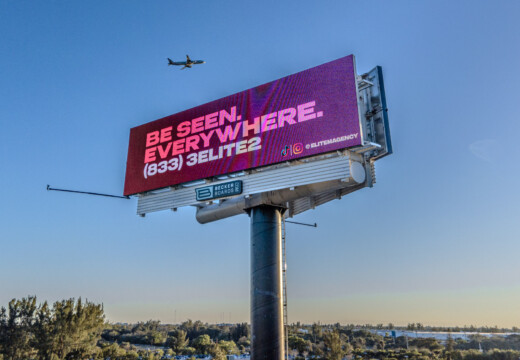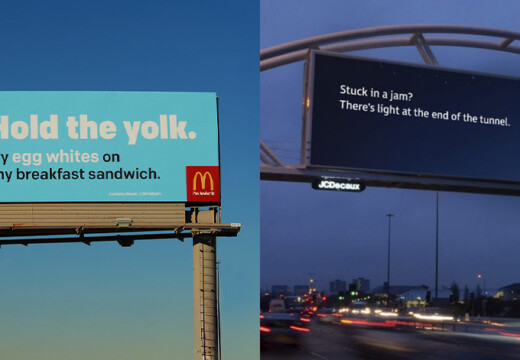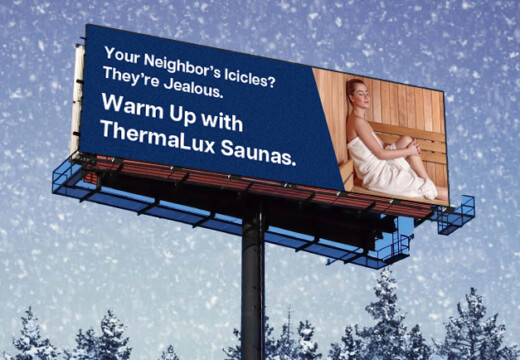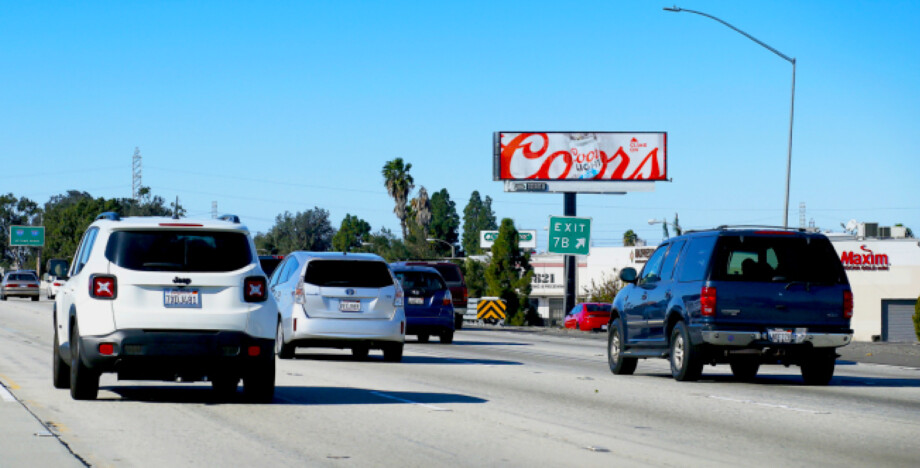
Get Attention, Drive Sales, and Make Your Marketing Dollars Work Harder
If you run a billboard campaign without a clear vision for how it fits into the rest of your marketing plan, you’ll likely have a hard time determining whether your efforts actually generated any results.
But if you know what job your billboards are supposed to do, keep track of your KPIs (key performance indicators), and get creative, you’ll find that billboards can power up the rest of your marketing like nothing else.
So, how do you integrate billboards into the rest of your marketing plans to get the most from your ad dollars? That’s what we’re covering today.
Omnichannel Marketing Doesn’t Have to Be Complicated or Costly
“Omnichannel” sounds complex, but it doesn’t have to be. It’s simply about showing up wherever your audience is and getting in front of them in multiple ways to catch their attention. With that out of the way, let’s jump in.
Why do You Need Multiple Channels in Your Marketing?
The general rule of thumb is that consumers need to see your messaging at least 7 times before they’re ready to buy from you. Don’t worry about the exact number; what’s more important is that people see you show up in multiple contexts throughout their day.
The human brain is very good at tuning out information it decides is not a high priority. But subliminal messaging can still impact a person over time. Meaning that multiple exposures to your message will increase the chance that a consumer will recall your brand when they have a need for your product.
In addition to the recall, showing up over and over again gives your prospects the impression that you’re everywhere – and if you’re everywhere, you must be very successful at delivering the solution they are looking for. This subtle leadership play is powerful social proof for your brand.
All of these advantages are great – but they only work if you get this one thing right…
Consistent Messaging is Everything
If someone sees two of your messages – in any media, online or off – and can’t immediately tell that they’re both from you, you lose any value you might have gotten from having multiple media formats all running at the same time.
There’s a subtle line to pay attention to here – you don’t necessarily want every single message to look exactly the same. Different styles, formats, and creative work better in different media. And by switching things up, you keep your creative fresh and avoid advertising fatigue.
But given that caveat, you do want your overarching message to be the same (along with branded components, like colors and fonts). This consistency will reinforce your communications and familiarize your audience with your brand.
And yes – this consistency needs to exist even between your online and offline media.
The Power of Mixing Offline and Online
You should keep doing what you’re doing online. Consumers may be burned out online, but that’s still where they’re spending their time.
What you need to do, though, is tie in offline media, like digital billboards, with your online efforts.
While most of consumers’ time spent online is entertainment-related (making advertising to them during that time largely a waste), certain behaviors around online shopping are picking up steam.
Customers are increasingly using their phones while shopping in-store: 69% of shoppers report that they would look at online reviews before approaching a store associate. Another 58% would compare other products or services online to what they’re shopping for in-store.
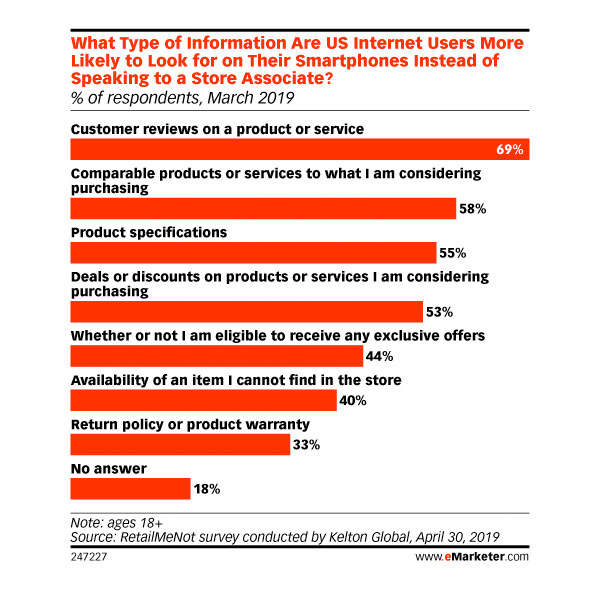
A further 74% of shoppers reported using the retailer’s app while in-store – primarily to check for discounts or deals or to research prices.
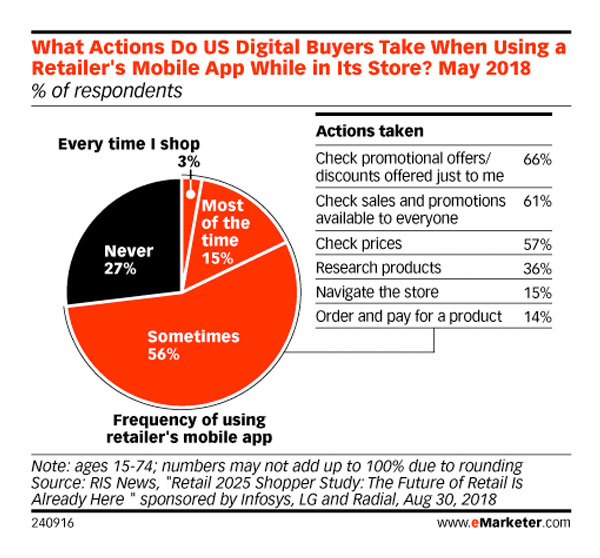
In another trend, social shopping, where the entire research and purchasing process is completed through a social media channel, is growing rapidly. The practice, worth some $475 billion in 2020, is expected to grow at nearly 30% per year through the rest of the decade – hitting $3.37 trillion by 2028.
Social shopping allows users to buy straight from their feeds. It also provides user-generated social proof. It brings together the worlds of eCommerce, social media, and interactive content.
Whether your business is at the stage of implementing these exact digital tactics or not, the point is that there are still precise online experiences shoppers are seeking with brands.
Adding digital billboards to your marketing mix doesn’t seek to replace your online presence: it complements and amplifies what you’re doing online.
How Billboards Impact Your Digital Marketing
Billboards can have a range of positive impacts on your online marketing efforts, from boosting engagement and recall to increasing conversions and lowering advertising costs.
Deployed correctly, digital billboards will help compensate for weaker online advertising performance. Together, online and offline efforts will work synergistically to improve brand recognition and grow sales.
Billboards and Search Engine Optimization
Billboards boost online searches for your products and services, website, and news about your brand.
As touched on earlier, amongst those who engaged with billboards, 43% visited the advertiser’s website, 39% searched online for more information, and 28% downloaded an app (rising to 46% and 38% of Gen Z and Millennials, respectively).
Besides the direct traffic to websites and apps, this research implies a significant correlation between billboards and branded or product-based online searches. Because these types of searches show a high intent to purchase, they are the most valuable kind for directly making sales or establishing long-term relationships with prospects through your content.
In a study of how 6 different advertising platforms drive people to take online actions, researchers found that billboards generate more search engine activity than all of the other platforms, except for TV (yet TV has vastly higher costs and a steadily shrinking viewership). It also tied TV as the leading medium to drive searches on both social media and video networks (like YouTube and Tiktok).
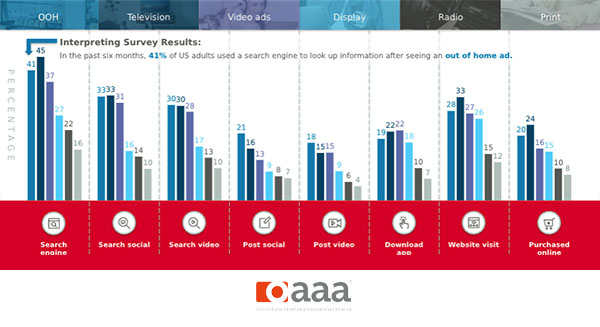
There are a couple of ways you can tie your SEO strategy and billboards together:
- Make sure your branding is front and center on your boards, and that when someone searches for your name they can actually find your website within the top few rankings on the main search engines. That way, you’ll see an increase in branded search terms. (And a higher click-through rate on those terms.)
- If you have some keywords you rank well for that competitors don’t, consider using them in your billboard messaging along with your branding. If someone doesn’t remember your name but does recall your messaging, they can search for that phrase and find you. Just make sure you’re not accidentally pointing them to a competitor!
- In a related tactic, if you beat out competitors in a “(category) near me” style search (for example, “plumbers near me,” “car wash near me,” etc.), let your billboard creative state your category loud and clear – try something like “Colorado’s #1 emergency plumber” (once again, only if you accurately fit that description and rank for that phrase!).
- If you have a unique advantage that none of your competitors have, whether that’s an idea or approach to doing something, or a unique product feature, and can call that out with a phrase that currently has no search traffic for either you or your competitors, try using that phrase on your billboards. To do this effectively, you’ll need to create some content on your website that will rank for that phrase. If your branding is clear on your boards, then you’re effectively telling people to search for this new, un-looked for search term, with your brand name. You’ll create a new search category on the search engines for something that you alone specialize in.
(To read more about these ideas, visit our blog post about billboards and SEO here.)
Billboards and Social Media
Just like billboards get people to look for you online, they also stimulate conversations on social media. Amongst younger generations, 67% report having seen a billboard ad reposted on social media, and over 80% of them would reshare an ad that gets their attention.
In the OAAA/Comcast study cited above, billboards beat every other media platform (including TV) for driving people to post on social media and video network sites.
Another study found that billboards increase reach on social media by up to 203%.[/vc_column_text][vc_column_text]Here are some ideas to integrate social media and billboards:
- Similar to the SEO tactics described above, choose a hashtag phrase that is unique to your brand. Create social media content using the hashtag, then promote the hashtag on billboards to drive traffic online.
- Launch a contest on social media to stimulate user-generated content. Promote the contest on your billboards. Make sure your branding is clear so people can find you online.
- Cross-post between your social and outdoor media. Encourage your followers near your billboard locations to take pictures of your billboard and post it online, tagging you. This gets your content in front of close families and friends of your most engaged audience, creating a clear path to new, warm leads. Your appearance on billboards will also lend you credibility to social media users, who will perceive your brand as being successful, established, and a leader in your industry (all things associated with advertisers in most forms of broadcast media, like billboards).
- For both integrating with social media and search engine optimization, make sure you use creative on your billboards that inspires curiosity and grabs attention. Curiosity will be the leading factor that motivates someone to go online to look for your website, product reviews, or social media accounts.
Billboards and Online Paid Advertising
The primary advantage of combining billboards with paid ads online is greater recall at a lower cost. This goes back to our earlier point about the need to show up in front of your audience multiple times to drive actions.
When someone has seen your billboard recently, even if they didn’t look closely or go online to find out more, it increases the chances that they’ll notice your online ads – the same ones that, without the exposure to your billboard, they would have ignored.
And seeing your ads for the second or third time might be what it takes to trigger a click.
That’s exactly what one company did when they wanted to test a campaign of just Facebook ads versus a blended campaign of billboards and Facebook ads.
To promote free downloads of their ebook, they launched two campaigns on the opposite side of the country (to avoid any chance of the control audience seeing the billboards for the test audience). They spent $2,213.79 on their blended campaign and $480.96 on their Facebook-only campaign (for a grand total of less than $2,700 – an incredibly affordable campaign budget).
The results blew them away:
- First, they found that it was 72.2% LESS expensive to reach the audience on Facebook and Instagram who saw billboards first.
- Once they adjusted this to include the cost of the billboards, they found their blended CPM (the merged cost-per-thousand impressions for the billboards-and-Facebook campaign) was $2.32; comparatively, the CPMs of the Facebook ads alone was $15.82.
- Put another way, this meant that to get the same number of impressions from a Facebook-only campaign, they would have had to spend $15,095 – a whopping 6.81x more than they actually did!
- They determined that splitting your ad budget 50% Facebook/Instagram and 50% billboards would unlock an increased 30-55% Return On Ad Spend (ROAS). Basically, your ad dollars will work 30-55% harder for you without increasing your budget.
- In a measure of how well a user recalled their ad, the blended campaign was twice as memorable as the Facebook-only campaign.
- When comparing cost-per-click, those who were not exposed to billboards clicked on the Facebook ads more, but the cost-per-click (CPC) was more than twice as high. Meaning that, once again, the blended campaign made the ad dollars work harder.
Finally, the Facebook ads were videos, so the team wanted to check whether people were actually getting something from engaging with the ads (i.e., that they were watching the video). The audience exposed to billboards was 17% more likely to complete the video than those who weren’t, meaning they got more value from the ad campaign.
To test out a similar strategy for yourself, here’s what you’ll need to do:
- Pick two locations with similarly sized populations (to get accurate results). The control location should be far enough away from the test location so that there’s no overlap.
- Pick some billboards in one of those locations and advertise an offer that requires an action (a download, signup, etcetera).
- Set up a geofencing campaign within Facebook for the locations of your billboards. Facebook will collect Mobile Ad IDs (MAIDs) from people who drive past the billboard and target them with an ad.
- Take the audience generated by this geofencing campaign and plug it into your Facebook Ads Manager to deploy your ads. Optimize for the Estimated Ad Recall Lift campaign goal to tell Facebook to show the ads to people most likely to remember seeing them. If you can update your audience every 24 hours, it ensures the campaign is as close to real time as possible.
- Create a Lookalike audience from your first audience in the location where you’re running your control campaign.
- Send the same creative to both audiences (your Facebook-only control audience and the blended test audience), then start measuring for differences in response rates and overall performance.
Tying It All Together
Digital billboards offer tremendous power to grow your brand, increase sales, and amplify the rest of your marketing – if used correctly.
To do so, forget about the standard, stale, boring billboard advertising that is both common and disconnected from the rest of the marketing mix.
Instead, using this guide as a roadmap, get creative. Have some fun with designing a campaign that is attention-getting and arouses curiosity. Then tie that into everything else you’re doing online.
Blip helps you do this by making the process of creating, deploying, and buying digital billboards easy, affordable, and low-risk. Once you join our platform, it’s as simple as choosing your locations, picking a daily budget, optimizing for time of day, and uploading your creative (or asking us to help you design your board!).
And if you have questions about how to make billboards work with the rest of your marketing, feel free to reach out. We’d be happy to help brainstorm some ideas.
Sources:
- Lucy Koch, “Two-Thirds of Shoppers Check Phones In-Store for Product Information, Skipping Store Associates,” eMarketer, 2019.
- Geri Mileva, “The State of Social Shopping in 2023,” Influencer Marketing Hub, 2022.
- “2022 Trends in OOH,” OAAA/The Harris Poll, 2021.
- “Consumer Insights: OOH and Online Activation,” OAAA/Comscore, 2022.
- “2022 Trends in OOH,” OAAA/The Harris Poll, 2021.
- “Why OOH Digital Billboard Advertising Study,” OAAA/USA TouchPoints, 2012.
- “How to Beat Facebook with Billboards: The Playbook,” Onescreen.ai, 2021.
